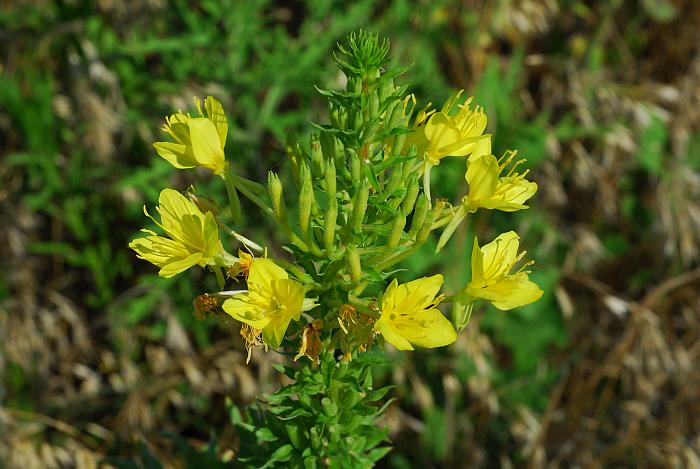Oenothera clelandii W. Dietr., P.H. Raven & W.L. Wagner
Sand Primrose

Native
CC = 5
CW = 5
MOC = 6
SRank = S2
© SRTurner
Oenothera clelandii W. Dietr., P.H. Raven & W.L. WagnerSand Primrose | |
 |
Native CC = 5 CW = 5 MOC = 6 SRank = S2 |
© SRTurner |
|
Family - Onagraceae Habit - Taprooted biennial forb. Stems - Ascending to erect, to 70 cm, often multiple from common base, often branched, densely pubescent with appressed, nonglandular hairs, thus often appearing grayish.
Leaves - Basal and alternate. Rosette leaves to 16 cm long, the blade narrowly oblanceolate, long-tapered to the sometimes indistinct petiole, the margins entire to deeply pinnately lobed with the terminal lobe larger than the lateral ones, the surfaces pubescent with short, appressed, nonglandular hairs. Stem leaves to 12 cm long, narrowly elliptic or lanceolate, sessile or short-petiolate, the lower ones nearly entire to deeply pinnately lobed, grading to entire or sparsely toothed upper leaves, the pubescence similar to the basal leaves, the secondary veins relatively inconspicuous.
Inflorescences - Dense spikes, usually unbranched, the mature buds not overtopping the tip of the inflorescence axis, straight, the subtending bracts persistent, these 10-25 mm long, lanceolate, the margins entire to bluntly few-toothed, the pubescence similar to that of the leaves.
Flowers - Actinomorphic, closing toward midday, the floral tube 15-40 mm long, sparsely to densely pubescent with appressed, nonglandular hairs, sometimes also with minute glandular hairs. Sepals 6-13 mm long, the midribs not keeled, with pubescence similar to the floral tube, the free tips in bud 0.5-2.0 mm long, terminal, erect and appressed. Petals 5-16 mm long, 3-11 mm wide, broadly elliptic to rhombicovate (rounded to more commonly pointed at the tip), light yellow to yellow. Stamens with the filaments 4-18 mm long, glabrous at the base, the anthers 2.0-3.5 mm long, yellow. Style 20-40 mm long, the stigma positioned near the anthers, deeply 4-lobed.
Fruits - Fruits to 20 mm long, 2-3 mm wide, narrowly lanceoloid, straight to curved, 4-locular, not winged, circular to very bluntly 4-angled in cross-section, the surface green, moderately to densely pubescent with short, appressed, nonglandular hairs. Seeds numerous in each locule, arranged in 2 rows, 1.0-1.9 mm long, 0.4-0.8 mm wide, ellipsoid, not angled, the surface brown, often flecked with dark brownish red spots, pitted.
Flowering - June - October. Habitat - Sand prairies, riverbanks, open sandy areas. Origin - Native to the U.S. Lookalikes - Other species of Oenothera. Other info. - This species is uncommon in Missouri and carries an S2 conservation ranking (imperiled and vulnerable to extirpation from the state). Its range in the state includes only four counties at the far northeastern corner. Beyond Missouri, its range continues northward, through Michigan, Wisconsin, and Minnesota. The plant can be very showy in the morning, when the flowers are open. The flowers close by late morning or early afternoon, especially on sunny days. Photographs taken at Rose Pond Conservation Area, Clark County, MO, 7-9-2017 (SRTurner). |